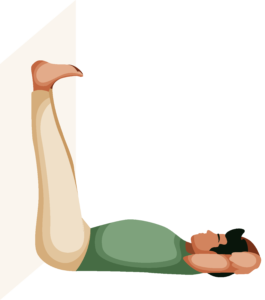Legs Up The Wall (Viparita Karani)
Pose Overview
| Common Name | Legs Up The Wall |
| Traditional Sanskrit Name | Viparita Karani |
| Sanskrit Name Pronunciation | vip-pah-reet-tah car-ah-nee |
| Pose Difficulty | Beginner |
| Drishti
Drishti is the gaze or visual focus point during yoga poses.
Learn more about Drishti |
Upward, towards the sky |
Legs Up The Wall Pose (Viparita Karani) is a yoga pose that is said to be beneficial for relieving stress, tension and fatigue, and promoting a sense of relaxation and tranquility. The name of the pose comes from the fact that it involves lying down on the floor with the legs extended up against a wall. This pose is said to be helpful for calming the mind and the body, relieving stress and tension and promoting a sense of relaxation and tranquility. It is also said to be beneficial for promoting a better sleep and for reducing fatigue. In traditional yoga practice, this pose is said to be associated with the element of water, and is said to improve flow and balance in the body. It is also said to be beneficial for reducing the symptoms of anxiety and depression by releasing tension in the body and promoting a sense of grounding and balance.
Benefits of Legs Up The Wall
Calms the nervous system Relieves stress and tension in the legs and lower back Improves circulation Reduces fatigue Alleviates menstrual discomfort
How to Enter Legs Up The Wall
Start by sitting on the floor with your hips close to a wall. Lie down on your back and swing your legs up onto the wall. Adjust your position so that your hips are close to the wall and your legs are straight. Rest your arms on the floor by your sides, and close your eyes. Hold the pose for as long as you are comfortable, at least 5 minutes is recommended.
How to Exit Legs Up The Wall
Slowly release your legs from the wall. Sit up and take a few deep breaths.
Common Legs Up The Wall Modifications & Variations
If you are pregnant, place a pillow or bolster under your hips for support. If you have any issues with your neck, place a pillow or folded blanket under your head for support. If you have any issues with your lower back, place a pillow or folded blanket under your hips for support.
Common Mistakes with Legs Up The Wall
Not keeping your hips close to the wall Not keeping your legs straight Not keeping your arms on the floor
Safety Guidance
If you have any issues with your lower back, use a pillow or folded blanket under your hips for support. If you have any issues with your neck, use a pillow or folded blanket under your head for support.

